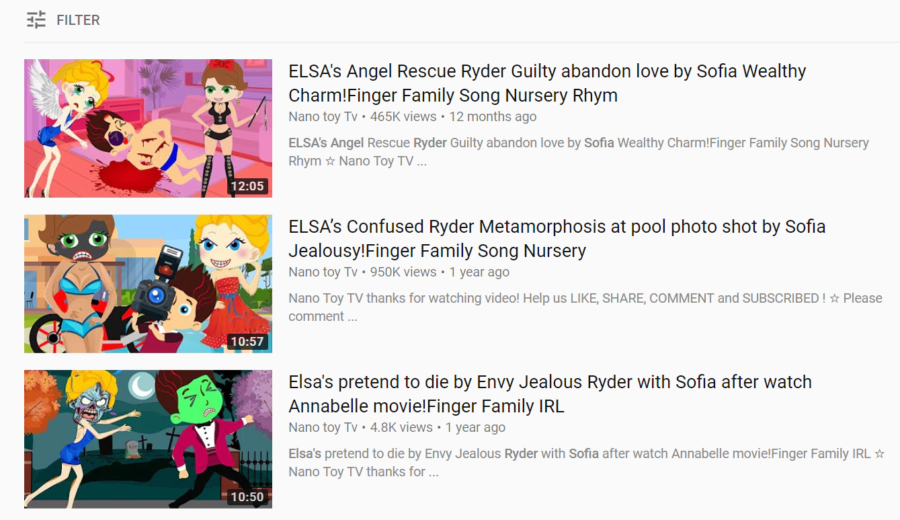The dark truth behind YouTube kids content
‘Nano Toy TV’ has had over 36 million views since its creation in 2016.
October 13, 2018
There’s nothing that can’t be found on the Internet.
For better or for worse, anyone with access to a smartphone or laptop has the ability to view and post as they please across nearly infinite websites. Social media is the most used aspect of the Internet, being the most effective way to reach an audience. Of those websites, one of the most popular is YouTube, where users can upload and watch videos.
Since its launch in 2005, YouTube has made a rapid rise to fame and now accumulates over 3.25 billion views every month. Over the course of these 13 years, different styles of videos have formed and created their own respective audience, but there’s one that has gone on ignored for far too long: “family friendly” content.
“Content for kids” has taken YouTube by storm. It’s no surprise that kids don’t require the peak of entertainment the way adults tend to, making it easier for the creators to make money. Churning out endless hours of content day by day, it’s undeniably evolved into an industry, and a massive one at that. It’s become an alternate form of TV; instead of sitting down for hours to watch their favorite shows on Nickelodeon and Disney, children oftentimes waste away on handheld devices, clicking on a video in their recommended tab and letting video after video play. The problem is that with YouTube’s algorithm, videos are generated with much more sinister messages hidden below the surface.
Armed with the knowledge that the children watching their videos are susceptible and easily influenced, the people behind the curtain have created a phenomenon teaching children odd fetishes and learned helplessness in order to fuel their own motives. The content starts off innocent, but immediately descends into bedlam as autoplay generates these unsettling videos. Animations teaching kids about colors quickly lead to videos of Disney characters being kidnapped, hypnotized and forced to strip.
And it’s not just one channel. Any disturbing kids content ends up redistributed among dozens of channels, ranging from dozens of views to billions. The recently popularized “Johnny Johnny” meme, stemming from a channel known as “Billion Surprise Toys” is a prime example of the creep factor YouTube kids content can have. The videos all have the similar plot of an animated family singing about a given topic, and there’s something unsettling about the animations and videos almost impossible to pinpoint. While those videos are clearly disturbing, it gets unbelievably worse.
Both live action and animated, related channels hold ominous themes that seem to link with each other. Among the most common are showings of syringes, surgeries and bondage-related violence. A now terminated Youtube channel entitled “Baby Toys” contained content disturbing beyond belief. Videos featured a child dressed as Elsa posing as if she were pregnant. A boy walks in, presumably her brother, and injects her stomach, representing abortion. Within their videos, these content creators incorporate sights such as gore, killer clowns and maggots crawling in and out of holes in a man’s hand, an image associated with the exceedingly common fear known as trypophobia. Their aim is to incite terror within the children watching the material and plant ideas in their head such as learned helplessness, a behavior common among abused children where they’re falsely taught that they have no control over their surroundings and instead must endure pain and abuse in order to survive.
It’s hard to sit through grossly twisted videos such as these and not lose hope in humanity. Still, it’s possible to break down piece by piece, and it starts with people bringing attention to this content. Near the end of 2017, both the mainstream media and the YouTube community finally began bringing attention to this problem. Media coverage may have died down since then, but the content hasn’t. There’s an undeniable flaw in YouTube’s system that will only worsen the more it’s ignored, and it’s up to everyone to stay speaking out against this monstrosity.









